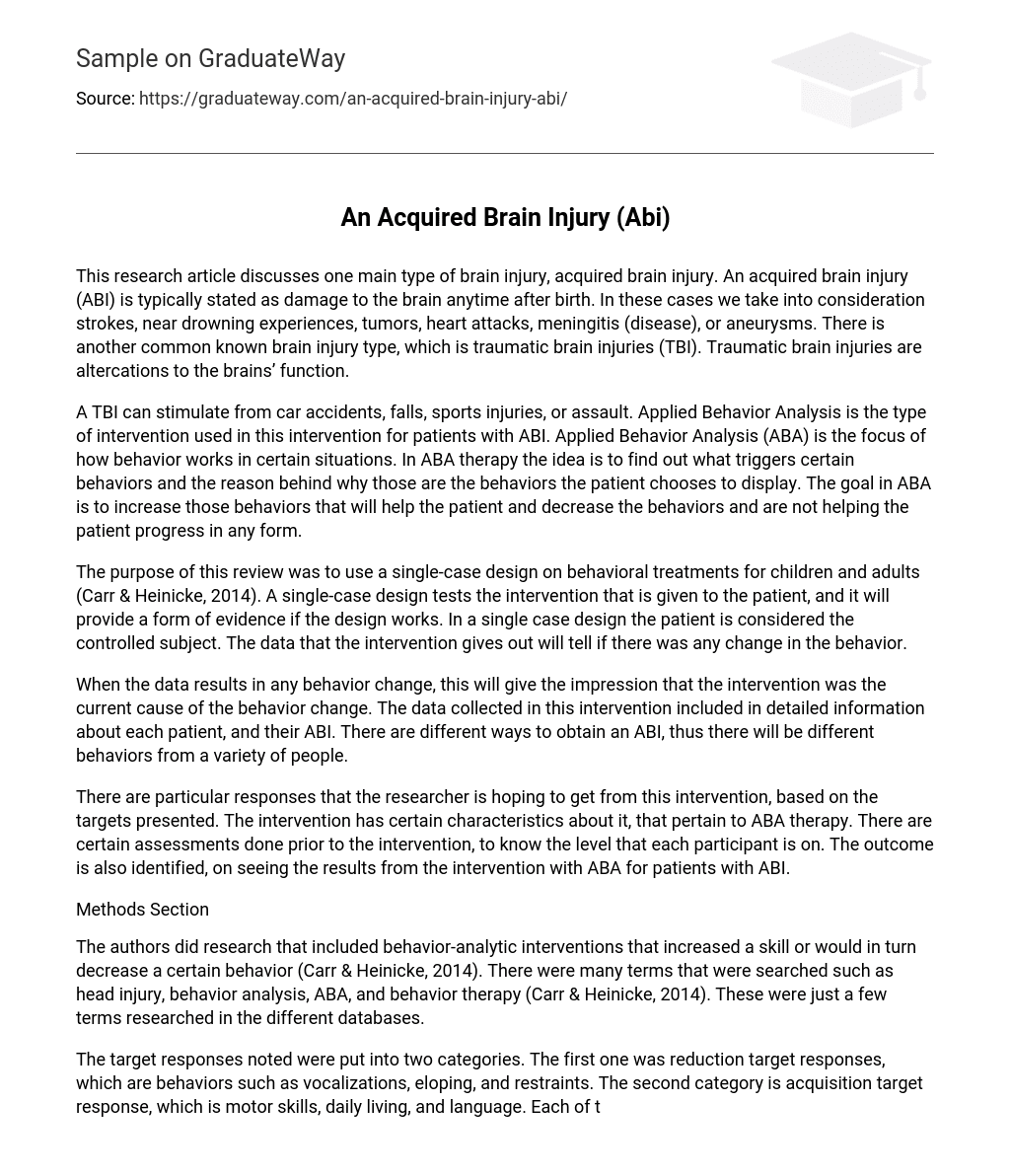This research article discusses one main type of brain injury, acquired brain injury. An acquired brain injury (ABI) is typically stated as damage to the brain anytime after birth. In these cases we take into consideration strokes, near drowning experiences, tumors, heart attacks, meningitis (disease), or aneurysms. There is another common known brain injury type, which is traumatic brain injuries (TBI). Traumatic brain injuries are altercations to the brains’ function.
A TBI can stimulate from car accidents, falls, sports injuries, or assault. Applied Behavior Analysis is the type of intervention used in this intervention for patients with ABI. Applied Behavior Analysis (ABA) is the focus of how behavior works in certain situations. In ABA therapy the idea is to find out what triggers certain behaviors and the reason behind why those are the behaviors the patient chooses to display. The goal in ABA is to increase those behaviors that will help the patient and decrease the behaviors and are not helping the patient progress in any form.
The purpose of this review was to use a single-case design on behavioral treatments for children and adults (Carr & Heinicke, 2014). A single-case design tests the intervention that is given to the patient, and it will provide a form of evidence if the design works. In a single case design the patient is considered the controlled subject. The data that the intervention gives out will tell if there was any change in the behavior.
When the data results in any behavior change, this will give the impression that the intervention was the current cause of the behavior change. The data collected in this intervention included in detailed information about each patient, and their ABI. There are different ways to obtain an ABI, thus there will be different behaviors from a variety of people.
There are particular responses that the researcher is hoping to get from this intervention, based on the targets presented. The intervention has certain characteristics about it, that pertain to ABA therapy. There are certain assessments done prior to the intervention, to know the level that each participant is on. The outcome is also identified, on seeing the results from the intervention with ABA for patients with ABI.
Methods Section
The authors did research that included behavior-analytic interventions that increased a skill or would in turn decrease a certain behavior (Carr & Heinicke, 2014). There were many terms that were searched such as head injury, behavior analysis, ABA, and behavior therapy (Carr & Heinicke, 2014). These were just a few terms researched in the different databases.
The target responses noted were put into two categories. The first one was reduction target responses, which are behaviors such as vocalizations, eloping, and restraints. The second category is acquisition target response, which is motor skills, daily living, and language. Each of these categories had numerous behaviors, but these were just a few that were mentioned on different occasions. There were 112 studies identified and recorded.
In most of the behaviors reduction evaluation it also assessed the effects of a single intervention to see if it actually reduced the target behavior (Carr & Heinicke, 2014). In each behavior evaluation there were at least five interventions assessed (Carr & Heinicke, 2014).
Results Section
The major function for most behaviors was escaping, or it can be referred to as eloping in ABA. There were behavior reductions seen in these interventions. The techniques that were seem as established for behavior were differential reinforcement, punishment, and antecedent interventions. In reducing problem behaviors self-management and extinction were seen as effective in this intervention (Carr & Heinicke, 2014). Extinction in the field of ABA is giving not attention to a previously reinforced behavior.
Discussion Section
The publication on articles in this information has not been very immense over the years. The data in experiments for this field is usually insufficient. The author wanted to give a close look on previous reviews done, by giving more detailed information than those in the past. The information in the past seemed to be very broad, on a subject that was hardly ever seemed researched in general.
In this research there were more behavior reductions identified than skill- acquisition evaluations ( Carr & Heinicke, 2014). The time duration for the behavior reductions were seen to be far longer than that of skill acquisition. The authors also discussed how they wanted to look more into the function of behaviors, but from prior research it was not used before reductive behavior interventions of this type for ABI rehabilitation patients. Escape was seen as the main function for most of the behaviors. When a patient is escaping, they are trying to leave from the evaluation site in some form.
Conclusion Section
This particular research done by the authors wanted to have all behavioral intervention studies with all participants who have an ABI diagnosis only. They wanted to do this to avoid any restrictive populations ( Carr & Heinicke, 2014). This research contained evidence base standard frameworks and quantitative measures of the effectiveness that were calculated for each treatment evaluation ( Carr & Heinicke, 2014).
These two pieces of information were not included in any previous research reviews. The authors of this research wanted to make sure that by them doing this research on interventions of ABA on patients with ABI, there would be more researchers willing to add to this study that has not been looked into very much.





